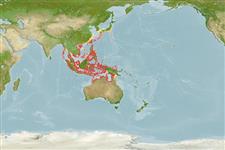>
Ovalentaria/misc (Various families in series Ovalentaria) >
Pomacentridae (Damselfishes) > Pomacentrinae
Etymology: Amphiprion: Greek, amphi = on both sides + Greek, prion, -onos = saw (Ref. 45335).
More on author: Cuvier.
Environment: milieu / climate zone / depth range / distribution range
Écologie
marin récifal; non migrateur; profondeur 1 - 15 m (Ref. 7247), usually 3 - 15 m (Ref. 55267). Tropical; 46°N - 17°S, 92°E - 147°E (Ref. 55267)
Indo-West Pacific: eastern Indian Ocean including Andaman and Nicobar Islands, Thailand, Malaysia, and northwest Australia to Singapore, Indonesia, and the Philippines; ranges north to Taiwan and the Ryukyu Islands.
Taille / Poids / Âge
Maturity: Lm ? range ? - ? cm
Max length : 11.0 cm TL mâle / non sexé; (Ref. 9710)
Description synthétique
Clés d'identification | Morphologie | Morphométrie
Épines dorsales (Total) : 10 - 11; Rayons mous dorsaux (Total) : 13 - 17; Épines anales: 2; Rayons mous anaux: 11 - 13.
Adults inhabit coral reefs where it lives among the venomous tentacles of large sea anemones (Ref. 85309). Occur in shallow and calm lagoons. Are protandrous hermaphrodites (Ref. 32167). Distinct pair is monogamous (Ref. 32167). Oviparous, distinct pairing during breeding (Ref. 205). Eggs are demersal and adhere to the substrate (Ref. 205). Males guard and aerate the eggs (Ref. 205). One of the most popular marine aquarium fishes. Bred artificially in Florida for the aquarium trade. Associated with the anemones: Heteractis magnifica, Stichodactyla gigantea, and Stichodactyla mertensii (Ref. 5911). Has been reared in captivity (Ref. 35410, 35413, 35415, 35418, 35420). Has reached an age of 12 years in captivity (Alexandre Fontayne, pers. comm., 2006).
Life cycle and mating behavior
Maturité | Reproduction | Frai | Œufs | Fécondité | Larves
Benthic spawner. Length at sex change = 4.4 cm TL (Ref. 55367). Oviparous, distinct pairing during breeding (Ref. 205). Eggs are demersal and adhere to the substrate (Ref. 205). Males guard and aerate the eggs (Ref. 205). Also Refs. 240, 7471, 118437.
Allen, G.R., 1991. Damselfishes of the world. Mergus Publishers, Melle, Germany. 271 p. (Ref. 7247)
Statut dans la liste rouge de l'IUCN (Ref. 130435: Version 2024-2)
Menace pour l'homme
Harmless
Utilisations par l'homme
Pêcheries: sans intérêt; Aquarium: Commercial
Outils
Articles particuliers
Télécharger en XML
Sources Internet
Estimates based on models
Preferred temperature (Ref.
123201): 26.2 - 29.3, mean 28.7 °C (based on 1746 cells).
Phylogenetic diversity index (Ref.
82804): PD
50 = 0.5000 [Uniqueness, from 0.5 = low to 2.0 = high].
Bayesian length-weight: a=0.01479 (0.00651 - 0.03363), b=3.00 (2.81 - 3.19), in cm total length, based on LWR estimates for this (Sub)family-body shape (Ref.
93245).
Niveau trophique (Ref.
69278): 3.1 ±0.36 se; based on food items.
Résilience (Ref.
120179): Haut, temps minimum de doublement de population inférieur à 15 mois (tm<1; Fec=600).
Fishing Vulnerability (Ref.
59153): Low vulnerability (10 of 100).
Nutrients (Ref.
124155): Calcium = 115 [69, 209] mg/100g; Iron = 0.909 [0.558, 1.451] mg/100g; Protein = 18.6 [17.5, 19.6] %; Omega3 = 0.142 [0.086, 0.235] g/100g; Selenium = 18.8 [10.6, 37.0] μg/100g; VitaminA = 223 [75, 636] μg/100g; Zinc = 1.84 [1.26, 2.60] mg/100g (wet weight);
